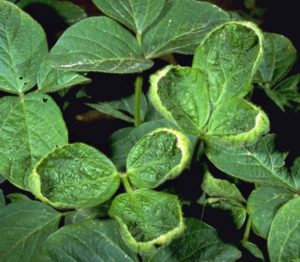Arkansas Plant Board Votes to Ban Dicamba — Now What?

A soybean plant showing telltale signs of dicamba injury: cupping and puckering. Credit: University of Arkansas Cooperative Extension Service
The Arkansas State Plant Board has voted to pass a proposed emergency rule to ban the use of in-crop dicamba, with an exemption for pastureland, and to expedite the rule increasing civil penalties for dicamba misuse.
The proposed rule is the first step in the process of establishing an emergency rule. The next step includes a review of the proposed rule by the governor before being submitted to the Executive Subcommittee of the Arkansas Legislative Council for approval.
“Governor (Asa) Hutchinson has followed this issue closely and previously tasked Secretary (Wes) Ward and ASPB Director (Terry) Walker with visiting farmers in areas with heavy dicamba damage. Governor Hutchinson will be conducting a thorough review of the proposed rule as soon as possible,” says Adriane Barnes, spokesperson for the Arkansas Agriculture Department.
As of the morning of Friday, June 23, the board had received 242 complaints about dicamba drift across 19 counties in the state — and the number continues to grow by the day. The complaints are what triggered the vote. Earlier in the week, the board passed further restrictions that would require hooded sprayers and a one-mile buffer in order to apply the in-crop use of dicamba.
“When you see those numbers of complaints, something is not working. It just gives me a lot of pause. I’m really anxious about it,” Andrew Thostenson, Pesticide Program Specialist with the North Dakota State University Extension Service, says. He adds: “I feel really bad for those people who had their crops damaged. This is not a deal where we’re talking $10 or $15 dollar soybeans — the margins are not where they’ve been in previous years. If you have a short crop because of a drift situation, it’s much more devastating at these lower prices.”

“I think we made a monumental effort to try to teach everyone, but I still think there was a lack of understanding by a lot of guys just how important it was to follow all of the regulations.” –Bob Scott; credit: University of Arkansas Division of Agriculture Research & Extension
Bob Scott, Professor and Weed Scientist at the University of Arkansas Cooperative Extension Service, spent about two weeks on the road when the complaints started coming in to take a look at the damaged fields and offer growers help. He tells CropLife that a majority of the drift damage reported up until about 10 days ago was on soybeans that were in the vegetative stage, when the crop is still able to recover somewhat if irrigated and sprayed properly thereafter. When injury occurs in this stage, “it does not usually result in big yield loss, according to our limited data. There is really nothing you can do except give them time to recover,” he says.
He is more concerned about complaints that have popped up in the last week, because despite the tropical depression that had moved through and delayed plantings, more plants would have still moved into the reproductive stage, where impact on seed production, plant development, and yield loss is much more severe.
Scott blames the drift problems in Arkansas primarily on wind movement and possibly inversions, as opposed to volatility, which BASF’s Engenia formulation (as well as Monsanto’s XtendiMax, although it is not labeled for use in Arkansas) addresses.
Impact of a Ban
In a state where about 35% to 40% of soybeans are Roundup Ready 2 Xtend, there were about a half-million acres of dicamba-tolerant soybean crops as of last week that either hadn’t been sprayed or could possibly need a second application of dicamba, according to an unscientific study Scott’s extension service team conducted. But that figure will decline each day as growers continue to spray until the governor reviews the rule. This number includes acres where Flexstar might still work and PPO resistance to pigweed has yet to develop.
“The bottom line is, if a farmer planted Xtend soybeans because he has PPO-resistant pigweed, he would be left without an option to control pigweed, so (a ban) would be a bad deal for those guys,” he says.
In some cases, Scott got calls to visit farms that had been accused of drifting to their neighbor’s fields, but there was no clear indication the growers had done anything out of line with the label requirements. “Those are the ones where you leave scratching your head. They are good applicators, have good records, and seemed to follow the guidelines well, and yet they still have unacceptable movement,” Scott says.
“Going into the fall, we’re really going to have to look at drift complaints, categorize and narrow them down, and try to figure out what’s going on here to determine whether we can use this technology or not … I think we made a monumental effort to try to teach everyone, but I still think there was a lack of understanding by a lot of guys just how important it was to follow all of the regulations. Also, unless you see it for yourself, it’s hard to believe how sensitive the soybean is to even the smallest amounts of dicamba. I just think a lot of guys didn’t really comprehend how bad it could be,” he says.
Scott says that in his experience, “most of the guys who got drift aren’t walking around mad. They just want the problem solved, and if the only way to solve it is a ban, then that’s fine with them. I don’t think they necessarily want that, but they just want to farm their crops and not be drifted on.”
He says, “We’re a pretty diverse state. We’ve got conventional soybean growers; we’ve got guys that like LibertyLink; and we’ve got guys that made the switch from Roundup to Xtend or Liberty to Xtend, and we’ve got vegetable growers. I’m a big believer that a guy should be able to grow whatever he wants on his land, and shouldn’t have to plant any one company’s type of bean just in self-defense, to prevent injury.”
Thostenson adds: “My heart goes out to those inspectors and people down there trying to figure out what’s going on. This is going to be very tough; the scale of problems is very big. Up here in North Dakota, if we have more than 50 or 60 complaints in a growing season you’ve got a major problem. You’re talking hundreds down there — that boggles the mind.”






